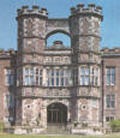An email from Ralph Gillis:
From: Rjg2432@aol.com [mailto:Rjg2432@aol.com]
Sent: Wednesday, November 21, 2012 4:30 AM
Subject: Brereton/Barrington
Hopefully a bit of information to help your Brereton research, and possibly a connection where you could help my Barrington research.
The Barringtons, originally "de Barenton", were Normans like the "de Breretons". The first recorded de Barenton arrived in England with Queen Emma. Later the name was changed to the less Norman "Barrington". The de Bareton/Barringtons settled in Essex and Cambridgshire, and were tied to the Mandevilles, Montfichets and DeVeres--baronies you might also check. Many Normans were in England, and Ireland for that matter, before the arrival of William in 1066. Everything I've run across about the Breretons suggests the same, and possibly you may want to look more closely at the retinue of Queen Emma for your roots.
My interest in the Breretons, especially as they came to Ireland, is to try to confirm the connection between my ancestor, ""John Barrington, of Cullenagh, Queens County, with the Essex Barringtons. There, simply put is a missing link in the documentation and the connections with Sir William Brereton and the Geraldine Revolt in 1539 may hold an answer.
John was a fiant (land grantee) of Queen Elizabeth, who received a grant to Cullenagh near Abbeyliex in 1564. He was one of the English captains Henry VIII and Sussex used to occupy the place as was John Brereton, son of Sir William. But he arrived in Ireland with Sir William Brereton in 1539.
The problem on the Essex side is that Burke's Peerage got it wrong as to the relationship of Essex with John of Cullenag. John is down as the son of Sir Thomas Barrington and Winifred, a Plantagenet. Now whether that was a confusion of names, as will be apparent in a bit, or intentional to get in on the royal line, is not clear. What is clear is that the dates in Burke do not align, and John, who was in Ireland in 1539, was not the son of Burke's Sir Thomas.
The Sir Thomas referenced by Burke is the great grandson of Nicholas Barrington. Nicholas also had a brother named "Sir Thomas Barrington", and this Sir Thomas Barrington was the father of another Thomas Barrington, Jr., who handled the estate of Burke's Sir Thomas Barrington's widow in 1538. Try following that!
A gentleman by the name of Lowndes, who put together the Essex Barrington tree, notes that after 1538 there is no further information on this earlier identified Thomas Barrington or his family after 1538. This statement is to my mind an intriguing point about the Lowndes Thomas Barrington, and suggests strongly that he is the ancestor of John Barrington of Cullenagh.
John Barrington of Cullenagh is described by Sir Henry Sidney (whose mother was an Essex Barrington) in a letter to Lord Burghley as being "a member of my family". Also Carew, in his effort to put together genealogies of the English settlers of the Pale, gives John Barrington of Cullenagh an Essex Barrington connection. That makes sense because historians describe Captain John Barrington as fighting under Sir William Brereton in Ireland in 1539.
Moreover the Domestic and Foreign Papers of Henry VIII show Sir William Brereton as going to Ireland in 1539 with two grand captains and three petty captains, about the time that the Lowndes Thomas Barrington and his family disappear from the Essex record. To my mind the connection of John Barrington of Cullenagh and the Thomas Barrington, Jr., whom Lowndes describes as disappearing with his family from the Essex records in 1538, is patent by the date. And the conversion point is that Sussex, whose wife was another Barrington, is the one who gave the grant of Cullenagh to John Barrington in 1564.
What I am trying to find is something in the records of Pale families which would reference either Thomas, George or John Barrington as being among the captains brought over by Sir William Brereton in 1538/9. George is mentioned because Amy Barrington in her 1917 books, The Barringtons, A Family History, mentions that John was sometimes known as George. Again, the clue is patent; Sir William Brereton, under whom John Barrington served as a captain, also had his son "John" with him as a captain. The confusion in a military unit between "Captain John Barrington" and "Captain John Brereton" would be unacceptable, so that John Barrington probably either used an alias or a middle name of "George".
The point of this dissertation is that while you have been reviewing information on the "six tribes" of English who settled in the Pale in the 17th century (includes Cosby and Brereton) have you run across the name Barrington and any associted references which would help me confirm the exact line between John Barrington of Cullenagh and the Essex Barringtons--probably Lowndes Thomas Barrington, Jr. of 1538. Just some reference to an English place name would do wonders.
Thank you for taking the time to read this, and any light or possible information source would be much appreciated.
Ralph Gillis
|

